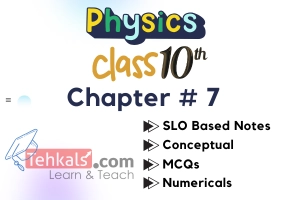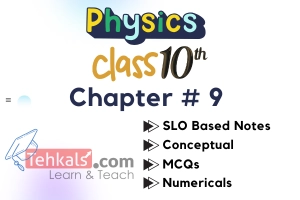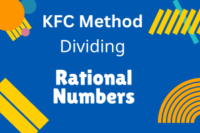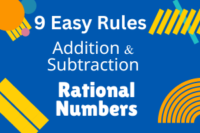Class 10 Physics Chapter 8
Published: 21 Dec 2023
Class 10 Physics Chapter 8 introduces the concept of “Information and Communication Technology”. This is mainly chapter No. 17, “Information and Communication Technology”, of the book of Class 10.
This article consists of Notes, SLO Based Notes and MCQs of Physics, which cover your course, board papers and clear your Physics concept for different types of tests.
Class 10 Physics Chapter 8 Notes
Information and Communication Technology
SLO Base Notes
Class 10 Physics Chapter 8 MCQs
1. What does ICT stand for?(a) Internet Computer Technology
(b) Information and Communication Technology
(c) Intelligent Computer Tools
(d) Integrated Communication Techniques
Show Answer
Information and Communication Technology
2. Which of the following best defines “Data”?
(a) Processed and meaningful information
(b) Software applications
(c) Unprocessed facts or figures
(d) Computer hardware components
Show Answer
Unprocessed facts or figures
3. Which of the following best defines “Information” in ICT?
(a) Raw and unstructured facts
(b) Organized and meaningful data
(c) Instructions for using hardware
(d) Physical components of a computer
Show Answer
Organized and meaningful data
4. What are physical computer components known as?
(a) Information
(b) Software
(c) Hardware
(d) Data
Show Answer
Hardware
5. Which of the following is considered a hardware component in ICT?
(a) Operating System
(b) Microsoft Word
(c) Spreadsheet software
(d) Keyboard
Show Answer
Keyboard
To Download Complete Notes of Physics Notes 10 Class, Click on the given link.
6. Which is a hardware component in ICT?(a) Windows software
(b) Printer
(c) Internet browser
(d) Document file
Show Answer
Printer
7. What are machine-readable instructions that tell a computer what to do called?
(a) Information
(b) Hardware
(c) Software
(d) Data
Show Answer
Software
8. Which of the following is an example of software?
(a) Computer monitor
(b) Microsoft Word
(c) Computer mouse
(d) Central Processing Unit (CPU)
Show Answer
Microsoft Word
9. Which component of an ICT system involves written manuals and documents for use?
(a) Data
(b) Hardware
(c) Procedures
(d) Software
Show Answer
Procedures
10. Who is responsible for designing and operating software in an ICT system?
(a) Hardware components
(b) Data analysts
(c) Procedures and rules
(d) Human resources
Show Answer
Human resources
11. In a telephone system, what is the path through which information flows?
(a) Air
(b) Vacuum
(c) Wires
(d) Seawater
Show Answer
Wires
12. How is information transmitted in radio, television, and cell phones?
(a) As sound waves
(b) As electromagnetic waves
(c) Via vacuum tubes
(d) None of these
Show Answer
As electromagnetic waves
13. In which form does information travel through optical fibers?
(a) Electrical signals
(b) Sound waves
(c) Electromagnetic waves
(d) Light
Show Answer
Light
14. What are signals in term of information transmission?
(a) Electrical or electromagnetic representations of data
(b) Airborne particles
(c) Sound waves
(d) Paper documents
Show Answer
Electrical or electromagnetic representations of data
15. What is the process of communication that involves the propagation and processing of signals to transmit data/information?
(a) Encoding
(b) Decoding
(c) Telepathy
(d) Transmission
Show Answer
Transmission
16. What happens to data or information in a wire-based communication technology?
(a) It is converted to sound
(b) It is transmitted and received as electrical signals
(c) It is transformed into digital signals
(d) It is propagated through the air
Show Answer
It is transmitted and received as electrical signals
17. In wire-based communication, what is converted into electrical signals at the transmitter?
(a) Sound
(b) Video
(c) Digital data
(d) Text messages
Show Answer
Sound
18. Which types of wires are commonly used in telephone networks and cable television for transmitting information?
(a) Copper wires
(b) Fiber-optic cables
(c) Twisted pair wires
(d) Wireless connections
Show Answer
Twisted pair wires
19. Why are amplifiers required for analog signal transmission in electrical wires?
(a) To reduce signal strength
(b) To convert analog to digital signals
(c) To extend the range of the signal
(d) None of these
Show Answer
To extend the range of the signal
20. What is the role of repeaters in digital transmission through wires?
(a) To amplify the signals
(b) To repeat or regenerate the digital signal
(c) To convert analog signals to digital
(d) To introduce noise into the signal
Show Answer
To repeat or regenerate the digital signal
21. How does an optical fiber transmit a signal-encoded beam of light?
(a) Through conduction
(b) By using metal wires
(c) By radio waves
(d) By total internal reflection
Show Answer
By total internal reflection
22. What is total internal reflection, and in which medium does it occur in optical fibers?
(a) It’s the reflection of light off metal surfaces
(b) It’s the reflection of light within a medium with a higher refractive index
(c) It’s the reflection of light in the atmosphere
(d) It’s the reflection of light within a vacuum
Show Answer
It’s the reflection of light within a medium with a higher refractive index
23. Which type of light source is more cost-effective and has a longer operational life in fiber optic systems?
(a) Light emitting diode (LED)
(b) Injection laser diode (ILD)
(c) Fluorescent light
(d) Incandescent light
Show Answer
Light emitting diode (LED)
24. What advantage does the injection laser diode (ILD) offer over the light emitting diode (LED) in optical fiber systems?
(a) It’s less costly
(b) It operates over a greater temperature range
(c) It has a longer operational life
(d) It’s more efficient and can sustain greater data rates
Show Answer
It’s more efficient and can sustain greater data rates
25. In step-index multimode optical fibers, how does light propagate within the fiber core?
(a) It follows a straight path along the core axis
(b) It is absorbed by the surrounding material
(c) It travels in a helical path
(d) It is reflected due to total internal reflection
Show Answer
It is reflected due to total internal reflection
26. Which type of optical fiber is best suited for transmission over very short distances?
(a) Single-mode
(b) Graded-Index multimode
(c) Step-index multimode
(d) None of these
Show Answer
Step-index multimode
27. In single-mode optical fibers, under what condition can light pass through the core?
(a) At any angle
(b) At low angles
(c) At only a single angle or mode
(d) At high angles
Show Answer
At only a single angle or mode
28. Which type of optical fiber is best suited for transmission over very long distances?
(a) Single-mode
(b) Graded-Index multimode
(c) Step-index multimode
(d) None of these
Show Answer
Single-mode
29. In which type of networks are graded-index fibers often used?
(a) Wide Area Networks (WAN)
(b) Local Area Networks (LAN)
(c) Global Area Networks (GAN)
(d) Metropolitan Area Networks (MAN)
Show Answer
Local Area Networks (LAN)
30. How are electrical signals representing information transmitted through radio-waves?
(a) Through optical fibers
(b) Via microwave signals
(c) By converting them into electromagnetic energy
(d) By using satellite communication
Show Answer
By converting them into electromagnetic energy
31. What converts radio-frequency electrical energy from the transmitter into electromagnetic energy for radiating into the surrounding environment?
(a) Antenna
(b) Receiver
(c) Microphone
(d) TV camera
Show Answer
Antenna
32. What happens when electromagnetic energy falls on the antenna during signal reception?
(a) It is absorbed by the antenna
(b) It is converted into radio-frequency electrical energy
(c) It is transmitted back to the transmitter
(d) It is converted into sound waves
Show Answer
It is converted into radio-frequency electrical energy
33. What is the primary role of the antenna?
(a) To generate electrical signals
(b) To convert sound into radio-frequency energy
(c) To convert radio-frequency energy into electromagnetic energy
(d) To transmit and receive radio-frequency signals
Show Answer
To transmit and receive radio-frequency signals
34. In two-way communication, can the same antenna be used for both transmission and reception?
(a) Yes
(b) No
(c) Only in specific situations
(d) Depends on the antenna type
Show Answer
Yes
35. How are sound waves from a radio station changed into electrical signals for transmission?
(a) By using optical fibers
(b) Through a process of photosynthesis
(c) By a microphone
(d) By satellite communication
Show Answer
By a microphone
36. What does a communication satellite primarily serve as?
(a) A solar panel
(b) A relay station
(c) A microwave oven
(d) None of these
Show Answer
A relay station
37. What is the term for machines or devices used to carry information to distant locations?
(a) Telepathy devices
(b) Teleportation devices
(c) Telecommunication devices
(d) Telescopic devices
Show Answer
Telecommunication devices
38. Which of the following is considered a telecommunication device?
(a) Refrigerator
(b) Tea maker
(c) Fax machine
(d) Coffee maker
Show Answer
Fax machine
39. Which of the following is not a telecommunication device?
(a) Cell phone
(b) Photo phone
(c) Television
(d) Bicycle
Show Answer
Bicycle
40. What is the primary function of telecommunication devices?
(a) To prepare food
(b) To carry information to distant places
(c) To control the weather
(d) To play music
Show Answer
To carry information to distant places
41. What is the primary purpose of a fax machine’s sending part?
(a) To control a printer
(b) To scan documents
(c) To receive electrical pulses
(d) To transmit signals wirelessly
Show Answer
To scan documents
42. How does a fax machine represent black and white when transmitting information?
(a) Using different phone lines
(b) By scanning in color
(c) Through electric pulses
(d) By sending binary code
Show Answer
Through electric pulses
43. Approximately how long does it take to transmit a single page of writing with a fax machine?
(a) Seconds
(b) About a minute
(c) Around 30 minutes
(d) None of these
Show Answer
About a minute
44. What is the signal reception area around a cell phone tower typically called?
(a) Zone
(b) Sphere
(c) Cell
(d) Network
Show Answer
Cell
45. What is the primary function of a photo phone?
(a) Transmitting images
(b) Transmitting sound using light
(c) Transmitting radio signals
(d) Transmitting sound through cables
Show Answer
Transmitting sound using light
46. When did optical communications (OC) start gaining attention?
(a) Early 1950s
(b) Late 1960s
(c) Early 1970s
(d) Early 1980s
Show Answer
Late 1960s
47. What technology played a crucial role in boosting optical communications in the 1960s?
(a) Radio waves
(b) Radar
(c) Laser and laser diode
(d) Optical fibers
Show Answer
Laser and laser diode
48. How are modern computers able to perform various tasks?
(a) By manual input only
(b) Through voice commands
(c) Via computer programming and generalized sets of operations
(d) By using only arithmetic operations
Show Answer
Via computer programming and generalized sets of operations
49. What development in the 1970s contributed to optical communications using light?
(a) Radio amplification
(b) Development of low-loss optical fibers (OFs)
(c) Laser technology
(d) Computer miniaturization
Show Answer
Development of low-loss optical fibers (OFs)
50. An electronic device for processing and storing data, capable of carrying out sequences of arithmetic or logical operations automatically through computer programming is called:
(a) A telecommunication device
(b) A gaming console
(c) A computer
(d) A microwave oven
Show Answer
A computer
51. What type of computer is known for being extremely large and is used in organizations for processing vast amounts of data?
(a) Personal computer
(b) Mainframe computer
(c) Laptop
(d) Desktop computer
Show Answer
Mainframe computer
52. What advantage does a mainframe computer have, making it capable of handling complex problem-solving efficiently?
(a) Portability
(b) Low cost
(c) Large memory and fast processor speeds
(d) Limited maintenance
Show Answer
Large memory and fast processor speeds
53. Which type of computer often has faster processors than laptops for the same price and is made up of separate components connected by wires?
(a) Personal computer
(b) Mainframe computer
(c) Laptop
(d) None of these
Show Answer
Personal computer
54. What is a notable disadvantage of laptops, making them less suitable for certain tasks?
(a) Lack of portability
(b) Limited battery life
(c) Fewer problems with overheating
(d) Inexpensive to operate
Show Answer
Limited battery life
55. What distinguishes a tablet from a laptop, focusing on user interface?
(a) Touch-screen typing
(b) Larger screen size
(c) Physical keyboard
(d) Operating system
Show Answer
Touch-screen typing
56. What is the disadvantage of tablets?
(a) Difficulty in touch-screen typing
(b) Quick to switch on
(c) Lack of downloadable applications
(d) Inability to make phone calls
Show Answer
Inability to make phone calls
57. What is a drawback of smart phones related to screen size?
(a) Better web browsing capability
(b) Difficulty in touch-screen typing
(c) Difficulty reading long documents
(d) Integration of contacts’ details
Show Answer
Difficulty reading long documents
58. What is the full form of E-mail?
(a) Electronic Memory
(b) Electrical Mailbox
(c) Efficient Message
(d) Electronic Mail
Show Answer
Electronic Mail
59. A worldwide system of computer networks is called:
(a) Games
(b) Internet
(c) Phone
(d) Computer
Show Answer
Internet
60. Which of the following requires electrical power for data storage and retrieval?
(a) Handwriting (paper documents)
(b) Phonographic recording
(c) DNA and RNA
(d) Electronic data storage
Show Answer
Electronic data storage
61. What is the primary function of primary storage devices in a computer?
(a) Store data permanently
(b) Hold data temporarily
(c) Provide external storage
(d) Store audio and video cassettes
Show Answer
Hold data temporarily
62. Which type of storage devices has the fastest data access speed?
(a) Primary storage devices
(b) Secondary storage devices
(c) USB storage devices
(d) Optical disk drives
Show Answer
Primary storage devices
63. Which of the following is an example of a primary storage device?
(a) Hard disk
(b) USB storage device
(c) RAM
(d) Optical disk drive
Show Answer
RAM
64. What is the primary characteristic of secondary storage devices?
(a) Small storage capacity
(b) Temporary data storage
(c) Large storage capacity and permanent data storage
(d) Exclusively external to the computer
Show Answer
Large storage capacity and permanent data storage
65. Which of the following is an example of a secondary storage device?
(a) RAM
(b) Cache memory
(c) USB storage device
(d) None of these
Show Answer
USB storage device
66. What is the primary composition of a floppy disk?
(a) Plastic carrier
(b) Optical material
(c) Metallic frame
(d) Ceramic substrate
Show Answer
Plastic carrier
67. How is data read and written from a floppy disk?
(a) Through a hard drive
(b) Using a floppy disk drive (FDD)
(c) Via optical disk drive
(d) By direct connection to a computer
Show Answer
Using a floppy disk drive (FDD)
68. What was one of the purposes of using floppy disks in the early days of personal computing?
(a) Storing multimedia files
(b) Distributing software
(c) Running complex algorithms
(d) Connecting to the internet
Show Answer
Distributing software
69. What is the storage capacity of a 3.5″ floppy diskette?
(a) 500 MB
(b) 1.44 MB
(c) 2 GB
(d) 5 MB
Show Answer
1.44 MB
70. What does CD stand for in term of storage media?
(a) Compact Disc
(b) Computer Data
(c) Code and Decode
(d) Central Drive
Show Answer
Compact Disc
71. What is a CD primarily used for?
(a) Playing music records
(b) Storing and playing back digital audio, video, and data
(c) Projecting holographic images
(d) Cooking recipes
Show Answer
Storing and playing back digital audio, video, and data
72. In term of storage media, what does DVD stand for?
(a) Digital Video Drive
(b) Data Versatile Disc
(c) Digital Versatile Disc or Digital Video Disc
(d) Diskette and Video Drive
Show Answer
Digital Versatile Disc or Digital Video Disc
73. How much data can a typical DVD store compared to a CD?
(a) Twice as much
(b) Four times as much
(c) Six times as much
(d) Ten times as much
Show Answer
Six times as much
74. What is the storage capacity of a standard DVD?
(a) 1.44 MB
(b) 700 MB
(c) 4.7 GB
(d) 2 TB
Show Answer
4.7 GB
75. What does USB stand for in term of a flash drive?
(a) Universal Serial Bus
(b) Ultra Storage Block
(c) User System Backup
(d) Unifying Storage Buffer
Show Answer
Universal Serial Bus
76. How does a flash drive connect to computers and devices?
(a) Infrared
(b) Bluetooth
(c) USB Type-A plug
(d) HDMI
Show Answer
USB Type-A plug
77. What distinguishes a flash drive from optical drives or traditional hard drives?
(a) It projects holographic images
(b) It has no moving parts
(c) It can cook recipes
(d) It uses data records for storage
Show Answer
It has no moving parts
78. What is the primary purpose of word processing software?
(a) Creating spreadsheets
(b) Manipulating text-based documents
(c) Editing images
(d) Designing graphics
Show Answer
Manipulating text-based documents
79. Which of the following is NOT a function of word processing software?
(a) Printing documents
(b) Formatting text
(c) Creating 3D models
(d) Correcting spelling and grammar
Show Answer
Creating 3D models
80. What is the primary goal of data management?
(a) Storing data
(b) Ensuring data accessibility, reliability, and timeliness
(c) Creating data
(d) Deleti
Show Answer
Ensuring data accessibility, reliability, and timeliness
ng data 81. In data management, what is the purpose of Standard Operating Procedures (SOPs)?
(a) Collecting data
(b) Analyzing data
(c) Ensuring consistency and adherence to procedures
(d) Deleting data
Show Answer
Ensuring consistency and adherence to procedures
82. Why is staff training essential in data management?
(a) To increase workload
(b) To adhere to SOPs
(c) To ignore data analysis
(d) To avoid data collection
Show Answer
To adhere to SOPs
83. What is the primary purpose of the Monitoring and Controlling process?
(a) Creating a project plan
(b) Comparing actual performance with planned performance
(c) Ignoring project metrics
(d) Minimizing project scope
Show Answer
Comparing actual performance with planned performance
84. When is the Monitoring and Controlling process performed throughout a project?
(a) Only at the beginning
(b) Only at the end
(c) Continuously throughout the project life
(d) At random intervals
Show Answer
Continuously throughout the project life
85. What corrective actions are taken in the Monitoring and Controlling process?
(a) Ignoring outcomes
(b) Taking no action
(c) Decreasing project scope
(d) Taking corrective actions to achieve desired outcomes
Show Answer
Taking corrective actions to achieve desired outcomes
86. What does the Monitoring and Controlling process aim to minimize?
(a) Project risks
(b) Project budget
(c) Project timeline
(d) Project scope
Show Answer
Project risks
Class 10 Physics MCQs (All Chapters)

- Be Respectful
- Stay Relevant
- Stay Positive
- True Feedback
- Encourage Discussion
- Avoid Spamming
- No Fake News
- Don't Copy-Paste
- No Personal Attacks



- Be Respectful
- Stay Relevant
- Stay Positive
- True Feedback
- Encourage Discussion
- Avoid Spamming
- No Fake News
- Don't Copy-Paste
- No Personal Attacks





